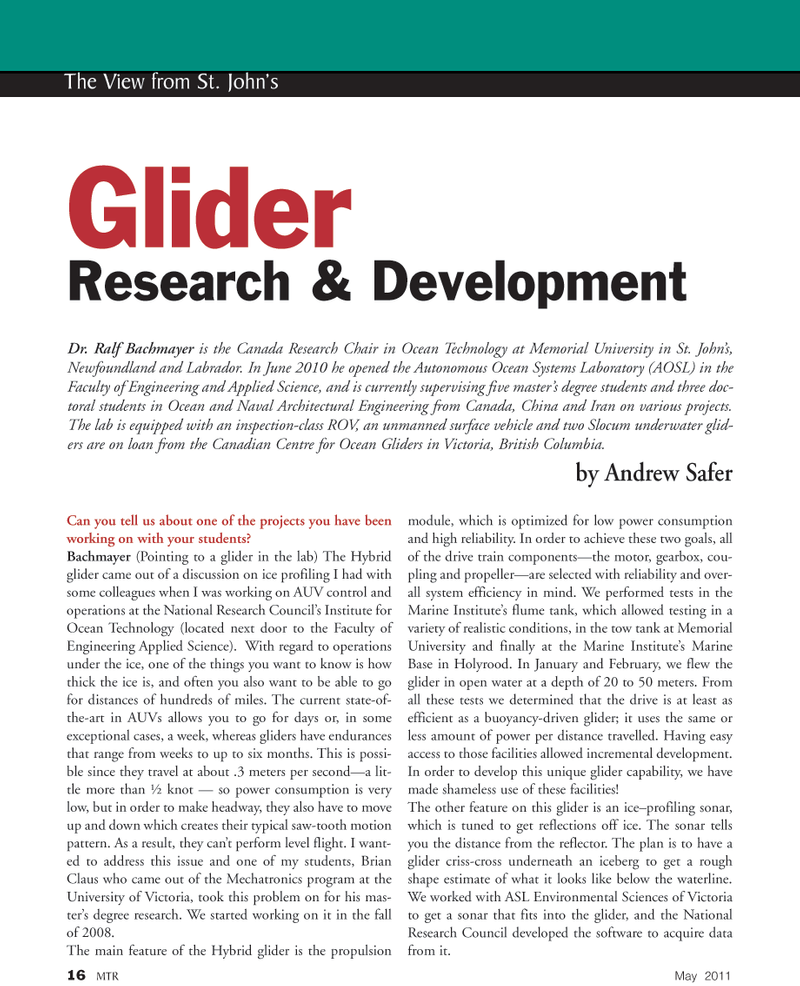
Page 16: of Marine Technology Magazine (May 2011)
Subsea Defense Edition
Read this page in Pdf, Flash or Html5 edition of May 2011 Marine Technology Magazine
Can you tell us about one of the projects you have been working on with your students?
Bachmayer (Pointing to a glider in the lab) The Hybrid glider came out of a discussion on ice profiling I had with some colleagues when I was working on AUV control and operations at the National Research Council’s Institute for
Ocean Technology (located next door to the Faculty of
Engineering Applied Science). With regard to operations under the ice, one of the things you want to know is how thick the ice is, and often you also want to be able to go for distances of hundreds of miles. The current state-of- the-art in AUVs allows you to go for days or, in some exceptional cases, a week, whereas gliders have endurances that range from weeks to up to six months. This is possi- ble since they travel at about .3 meters per second—a lit- tle more than ½ knot — so power consumption is very low, but in order to make headway, they also have to move up and down which creates their typical saw-tooth motion pattern. As a result, they can’t perform level flight. I want- ed to address this issue and one of my students, Brian
Claus who came out of the Mechatronics program at the
University of Victoria, took this problem on for his mas- ter’s degree research. We started working on it in the fall of 2008.
The main feature of the Hybrid glider is the propulsion module, which is optimized for low power consumption and high reliability. In order to achieve these two goals, all of the drive train components—the motor, gearbox, cou- pling and propeller—are selected with reliability and over- all system efficiency in mind. We performed tests in the
Marine Institute’s flume tank, which allowed testing in a variety of realistic conditions, in the tow tank at Memorial
University and finally at the Marine Institute’s Marine
Base in Holyrood. In January and February, we flew the glider in open water at a depth of 20 to 50 meters. From all these tests we determined that the drive is at least as efficient as a buoyancy-driven glider; it uses the same or less amount of power per distance travelled. Having easy access to those facilities allowed incremental development.
In order to develop this unique glider capability, we have made shameless use of these facilities!
The other feature on this glider is an ice–profiling sonar, which is tuned to get reflections off ice. The sonar tells you the distance from the reflector. The plan is to have a glider criss-cross underneath an iceberg to get a rough shape estimate of what it looks like below the waterline.
We worked with ASL Environmental Sciences of Victoria to get a sonar that fits into the glider, and the National
Research Council developed the software to acquire data from it. 16 MTR May 2011
The View from St. John’s
Glider
Research & Development
Dr. Ralf Bachmayer is the Canada Research Chair in Ocean Technology at Memorial University in St. John’s,
Newfoundland and Labrador. In June 2010 he opened the Autonomous Ocean Systems Laboratory (AOSL) in the
Faculty of Engineering and Applied Science, and is currently supervising five master’s degree students and three doc- toral students in Ocean and Naval Architectural Engineering from Canada, China and Iran on various projects.
The lab is equipped with an inspection-class ROV, an unmanned surface vehicle and two Slocum underwater glid- ers are on loan from the Canadian Centre for Ocean Gliders in Victoria, British Columbia. by Andrew Safer

 15
15

 17
17
